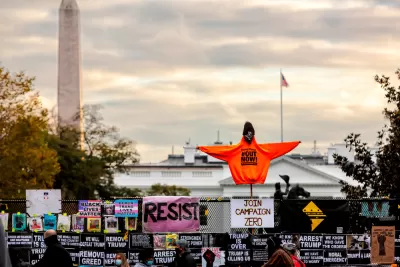The Biden and Trump campaigns are from different worlds on housing policy, according to this analysis.

"Whether voters choose a Trump administration or a Biden administration, the next president of the United States could face a daunting 30 to 40 million households at risk for evictions," writes Sadef Ali Kully, citing data from August.
Despite the risks, the presidential campaign of has been defined by a lack of substantive discussion of the looming housing crisis, but the track record and platforms of the candidates reveal more about what might be expected in the case of either winning the election.
In describing Trump's housing policy platform, Kully notes that a presidential career spent weakening fair housing laws in the United States was preceded by a previous career as a developer accused of fair housing violations.
In addition to its actions on fair housing, the Trump administration also introduced a housing finance reform plan in 2016 that "seeks to restructure and release Fannie Mae and Freddie Mac from federal government conservatorship, which occurred after the 2008 Great Recession," according to Kully.
Among Trump's other related accomplishments, Kullu lists the Opportunity Zones program, which offers tax incentives for investments in designated low-income areas. That program has been dogged by controversy throughout its relatively short existence.
As for Biden, Kully notes the former vice president's time in the U.S. Senate, when he wrote 11 pieces of legislation related to housing and development. Unlike the Trump campaign, the Biden campaign released an official housing plan, focusing on four main goals for housing: "Ending redlining and other discriminatory practices in the housing market, providing financial assistance for tenants and first time homeowners, increasing the housing supply and lowering the costs of quality housing and lastly, a comprehensive plan which will work towards ending homelessness."
Kully provides more details on Biden's housing platform heading into the election:
Biden also supports the Legal Assistance to Prevent Evictions Act of 2020, which will help tenants facing eviction gain access to legal assistance, similar to New York City’s Right to Counsel program. He plans on enacting legislation to prevent exclusionary zoning by requiring any state receiving federal dollars through the Community Development Block Grants or Surface Transportation Block Grants, paired with an investment of $300 million in Local Housing Policy Grants to give local governments technical assistance and planning support.
The list goes on, Biden's housing policy showing as far more robust than Trump's—an angle that should be apparent from the headline of the source article: the two campaigns are on different worlds of housing policy.
FULL STORY: Trump and Biden are in Different Worlds on Housing

Montreal Mall to Become 6,000 Housing Units
Place Versailles will be transformed into a mixed-use complex over the next 25 years.

Planetizen Federal Action Tracker
A weekly monitor of how Trump’s orders and actions are impacting planners and planning in America.

DARTSpace Platform Streamlines Dallas TOD Application Process
The Dallas transit agency hopes a shorter permitting timeline will boost transit-oriented development around rail stations.

Philadelphia Swaps Car Lanes for Bikeways in Unanimous Vote
The project will transform one of the handful of streets responsible for 80% of the city’s major crashes.

Interactive Map Reveals America's “Shade Deserts”
Launched by UCLA and American Forests to combat heat-related deaths, the tool maps the shade infrastructure for over 360 U.S. cities.

Bicycles and Books — In Sacramento, Libraries Now Offer Both
Adult library card holders can check out e-bikes and e-trikes for up to one week.
Urban Design for Planners 1: Software Tools
This six-course series explores essential urban design concepts using open source software and equips planners with the tools they need to participate fully in the urban design process.
Planning for Universal Design
Learn the tools for implementing Universal Design in planning regulations.
City of Mt Shasta
City of Camden Redevelopment Agency
City of Astoria
Transportation Research & Education Center (TREC) at Portland State University
US High Speed Rail Association
City of Camden Redevelopment Agency
Municipality of Princeton (NJ)





























